Discover Florida Nature
It's time to explore the natural Florida


|
|
|
|
|
Bats are mammals. They account for more than 25 percent of all the
mammals on the earth! Bats are the only mammals that can fly. There are
good reasons to appreciate bats in Florida. One of the wonderful things
that most bats do is eat insects! By eating their body weight in
insects each night, bats are the most important controller of
night-flying insects, including many crop pests. Some bats eat fruit,
nectar and seeds from plants. When the bats spit out the seeds or leave
them in their droppings, they help new plants to grow. They also
pollinate many kinds of plants, including vanilla beans, peaches,
bananas and avocados.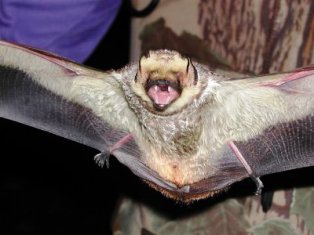 Hoary
Bat- The most beautiful of Florida's bats is the hoary bat.
Hoary bats can't be easily confused with any other bat in Florida. Their
fur is a mixed brown-gray color with heavy white fringe, giving them a
frosted appearance. Hoary bats are not considered residents because they
are found in Florida only during the spring and autumn when they migrate
to and from Mexico and South America, where they spend the winter
months. Hoary bats spend the summer days hidden in the foliage of trees.
Much like the red bat, they choose a leafy site open beneath them, and
usually 10-15 feet above the ground. Because hoary bats are solitary
roosting bats and keep themselves well hidden, this species is usually
never encountered by humans. In the evening, the hoary bat emerges late,
and like red bats, they may wake and fly during late afternoons on warm
winter days. Almost nothing is known of the feeding habits of this
species, however it is suggested that hoary bats feed on moths,
beetles, and
mosquitoes. Hoary bats mate in the fall and like most bats do not
become pregnant until early spring. Hoary
Bat- The most beautiful of Florida's bats is the hoary bat.
Hoary bats can't be easily confused with any other bat in Florida. Their
fur is a mixed brown-gray color with heavy white fringe, giving them a
frosted appearance. Hoary bats are not considered residents because they
are found in Florida only during the spring and autumn when they migrate
to and from Mexico and South America, where they spend the winter
months. Hoary bats spend the summer days hidden in the foliage of trees.
Much like the red bat, they choose a leafy site open beneath them, and
usually 10-15 feet above the ground. Because hoary bats are solitary
roosting bats and keep themselves well hidden, this species is usually
never encountered by humans. In the evening, the hoary bat emerges late,
and like red bats, they may wake and fly during late afternoons on warm
winter days. Almost nothing is known of the feeding habits of this
species, however it is suggested that hoary bats feed on moths,
beetles, and
mosquitoes. Hoary bats mate in the fall and like most bats do not
become pregnant until early spring.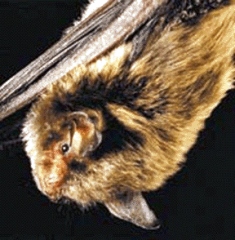 Indiana
Bat- The Indiana bat is a medium-sized bat, closely resembling
the little brown bat but differing in coloration. Its fur is a dull
grayfish chestnut rather than bronze, with the basal portion of the
hairs of the back dull lead colored. This bat's underparts are pinkish
to cinnamon, and its hind feet smaller and more delicate than the little
brown bat. It's heel of the foot is strongly keeled. The Indiana bat is
an
endangered mammal in Florida. With the coming of spring, Indiana
bats disperse from their winter homes, known as hibernacula, some going
hundreds of miles. They feed solely on
flying insects and presumably males spend the summer preparing for
the breeding season and winter that follows. Females congregate in
nursery colonies, only a handful of which have ever been discovered. Indiana
Bat- The Indiana bat is a medium-sized bat, closely resembling
the little brown bat but differing in coloration. Its fur is a dull
grayfish chestnut rather than bronze, with the basal portion of the
hairs of the back dull lead colored. This bat's underparts are pinkish
to cinnamon, and its hind feet smaller and more delicate than the little
brown bat. It's heel of the foot is strongly keeled. The Indiana bat is
an
endangered mammal in Florida. With the coming of spring, Indiana
bats disperse from their winter homes, known as hibernacula, some going
hundreds of miles. They feed solely on
flying insects and presumably males spend the summer preparing for
the breeding season and winter that follows. Females congregate in
nursery colonies, only a handful of which have ever been discovered.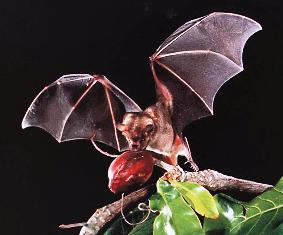 Jamaican
Fruit Bat- The Jamaican fruit bat has gray-brown fur and
indistinct, whitish facial stripes. It has no tail, and the membrane
stretching between its legs is small and u-shaped. Its length is about
3.5 inches. The Jamaican fruit bat has a fleshy nose leaf resembling a
third ear positioned on the muzzle. The Jamaican fruit bat is one of the
heavier species, weighing 40–65 grams (1.4–2.3 ounces). This bat smells
like perfumed soap. These bats can be found in the dry deciduous and
tropical evergreen forests of Mexico, south to northern Argentina and
the Lesser and Greater Antilles. The Jamaican fruit bat mainly eats
fruit but they will supplement their diet with pollen, nectar and small
insects if necessary. Jamaican
Fruit Bat- The Jamaican fruit bat has gray-brown fur and
indistinct, whitish facial stripes. It has no tail, and the membrane
stretching between its legs is small and u-shaped. Its length is about
3.5 inches. The Jamaican fruit bat has a fleshy nose leaf resembling a
third ear positioned on the muzzle. The Jamaican fruit bat is one of the
heavier species, weighing 40–65 grams (1.4–2.3 ounces). This bat smells
like perfumed soap. These bats can be found in the dry deciduous and
tropical evergreen forests of Mexico, south to northern Argentina and
the Lesser and Greater Antilles. The Jamaican fruit bat mainly eats
fruit but they will supplement their diet with pollen, nectar and small
insects if necessary. 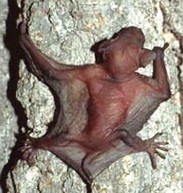 Little
Brown Bat-The little brown bat is a small mammal with a body
length of 3 - 31/2 inches and weighing approximately 1/8 to 1/2 an
ounce. The wingspan of little brown bats range from 6 - 8 inches. As
their name suggests little brown bats are glossy brown above with a
light buff color below. These bats can live 20 to 30 years. In summer
the little brown bat inhabits trees, bat houses, and buildings, usually
choosing a hot attic, where nursery colonies of hundreds and even
thousands form. Less frequently colonies form beneath tar paper, siding,
shingles, or other similar sheltered spots,. In the west colonies have
been found beneath bridges and in caves. Single males have been found in
attics, behind shutters under bark, in rock crevices, behind siding and
under shingles. Groups of males occasionally occur in caves. Little
Brown Bat-The little brown bat is a small mammal with a body
length of 3 - 31/2 inches and weighing approximately 1/8 to 1/2 an
ounce. The wingspan of little brown bats range from 6 - 8 inches. As
their name suggests little brown bats are glossy brown above with a
light buff color below. These bats can live 20 to 30 years. In summer
the little brown bat inhabits trees, bat houses, and buildings, usually
choosing a hot attic, where nursery colonies of hundreds and even
thousands form. Less frequently colonies form beneath tar paper, siding,
shingles, or other similar sheltered spots,. In the west colonies have
been found beneath bridges and in caves. Single males have been found in
attics, behind shutters under bark, in rock crevices, behind siding and
under shingles. Groups of males occasionally occur in caves. 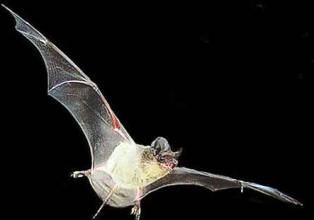 Mexican
Free-tailed Bat- The Mexican free-tailed bat (Tadarida
brasiliensis) is a medium sized bat. Their bodies are about 9
centimeters in length, and they weigh about 15 grams. Their ears are
wide and set apart to help them find prey with echolocation. Its fur
color varies from dark brown to gray. Mexican free-tailed bats live in
caves in the southern United States, Mexico, Central America, the West
Indies, central Chile and Argentina. Their colonies are the largest
congregations of mammals in the world! The largest colony is found at
Bracken Cave, north of San Antonio, Texas, with nearly 20 million bats.
The bats of Bracken Cave can eat up to 250 tons of insects per night! Mexican
Free-tailed Bat- The Mexican free-tailed bat (Tadarida
brasiliensis) is a medium sized bat. Their bodies are about 9
centimeters in length, and they weigh about 15 grams. Their ears are
wide and set apart to help them find prey with echolocation. Its fur
color varies from dark brown to gray. Mexican free-tailed bats live in
caves in the southern United States, Mexico, Central America, the West
Indies, central Chile and Argentina. Their colonies are the largest
congregations of mammals in the world! The largest colony is found at
Bracken Cave, north of San Antonio, Texas, with nearly 20 million bats.
The bats of Bracken Cave can eat up to 250 tons of insects per night!
|
|
|
Advertise | Privacy Statement | Contact | Alaska Nature | Michael Arnold Art| Dog Encyclopedia | Dog Encyclopedia| |
|